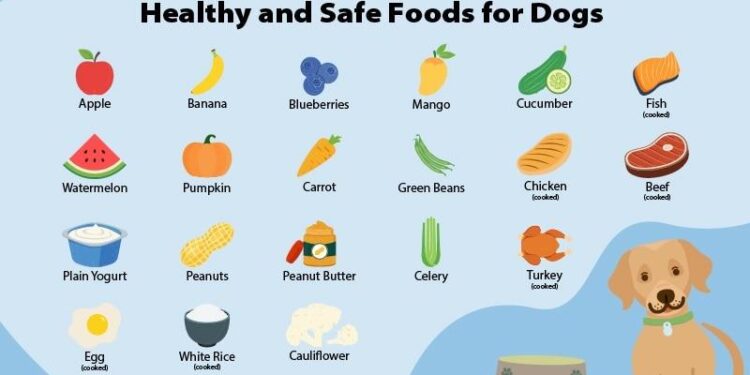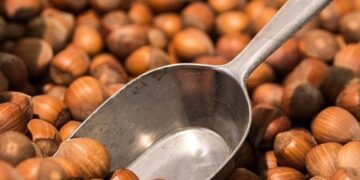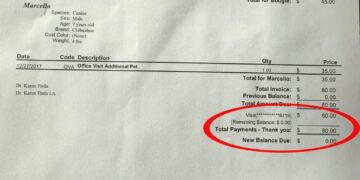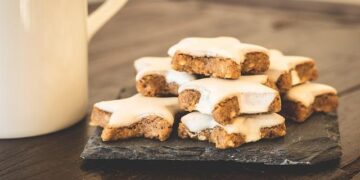Table of Contents
My name is Nora, and for the last decade, I’ve dedicated my professional life to the science of dog nutrition.
I’ve consulted with countless owners, formulated diet plans, and prided myself on staying at the forefront of veterinary nutritional science.
But my most profound, and humbling, lesson didn’t come from a textbook or a research paper.
It came from my own Labrador, Max.
Max was my heart dog.
A goofy, sun-yellow Lab with an unquenchable love for life, tennis balls, and, of course, food.
From the day I brought him home, I did everything by the book.
I bought the most premium, scientifically formulated kibble on the market—a brand proudly displaying its AAFCO “complete and balanced” statement.1
I meticulously measured every meal with a kitchen scale, following the feeding chart on the back of the bag to the gram.2
I was a nutrition practitioner, after all.
If anyone could get this right, it should have been me.
But I was failing.
Despite my diligence, Max was perpetually on the wrong side of a healthy weight.
He was sluggish on our walks, his once boundless energy waning.
I remember the sharp, frustrating sting of a vet visit that became a turning point.
The vet, a kind woman who knew my profession, gently placed a hand on Max’s side.
“Nora,” she said, her voice soft but firm, “he’s carrying too much weight.
We’re heading into territory where we have to worry about joint problems, metabolic disease…
the works.”.3
I felt a wave of shame and confusion.
I was following the rules.
I was doing everything the experts, the labels, and my own training told me to do.
Yet, the evidence was right there in front of me: my beloved dog was unhealthy, and my expertise felt useless.
That frustrating vet visit sent me down a rabbit hole.
I began to question the very foundation of the advice I had so faithfully followed.
It led me to throw out the conventional rulebook and look for answers in a field that seemed, at first, completely unrelated.
The journey that followed didn’t just help me solve Max’s weight problem; it gave me a completely new framework for understanding how to feed not just Labradors, but every unique dog.
It forced me to answer the question that I know so many of you are asking: If the experts and the food labels are wrong, what is the right way to feed a Labrador?
Part I: The Labrador Paradox: Why a Breed Hard-Wired for Hunger Can’t Use a One-Size-Fits-All Rulebook
To understand why the standard advice fails so many Labradors, we first have to deconstruct it.
We need to look at what the rules on the bag actually mean and then examine the unique, powerful biology that makes Labradors an exception to those rules.
Deconstructing the Standard Advice: The AAFCO “Safety Net”
Every reputable bag of dog food features a “nutritional adequacy statement” from the Association of American Feed Control Officials (AAFCO).
This statement confirms the food is “complete and balanced” for a specific life stage, like “growth” for puppies or “adult maintenance”.1
AAFCO also requires that these complete-and-balanced foods provide feeding directions, which must, at a minimum, state “Feed (amount of product) per (weight) of dog”.1
For years, I, like most owners, interpreted this label as a prescription.
“Complete and balanced” sounds like “perfectly optimized for your dog.” The feeding chart feels like a doctor’s dosage instructions.
This interpretation is the source of so much owner frustration, because it’s fundamentally incorrect.
The primary purpose of AAFCO guidelines is not to provide a tailored nutritional plan for your individual dog; it is to establish a minimum safety standard to prevent widespread nutritional deficiencies across the entire canine population.6
Think of it as a nutritional “floor,” not a customized “ceiling.” The guidelines ensure that a food contains the 40-plus essential nutrients required for life, but they are, by necessity, generic.
Even AAFCO and veterinary nutritionists acknowledge that these directions are just a starting point and must be adjusted based on an individual animal’s age, activity level, and body condition.5
Relying solely on the bag’s instructions for a breed as metabolically unique as a Labrador is like using a map of the United States to find a specific house in Chicago.
It gets you into the right general area, but it’s utterly useless for the precision required to arrive at the correct destination.
This realization is the first step to freeing yourself from the guilt of “failing” when the one-size-fits-all instructions inevitably don’t work for your one-of-a-kind dog.
The “Hunger Gene” Decoded: The Scientific Reason Your Lab Is Always Hungry
For decades, the Labrador’s legendary appetite was chalked up to them being “food-motivated” or just plain “greedy.” Owners felt blamed, and dogs were labeled.
But recent science has provided a stunning explanation that shifts the narrative entirely.
In 2016, researchers at the University of Cambridge identified a specific genetic mutation in the pro-opiomelanocortin (POMC) gene that is remarkably common in Labrador Retrievers.9
This isn’t just a vague predisposition; it’s a specific, identifiable genetic anomaly that creates a metabolic “double-whammy” for affected dogs.
First, the POMC gene is responsible for producing two key chemical messengers in the brain—beta-MSH and beta-endorphin—that signal satiety, the feeling of being full after a meal.10
The mutation disrupts the production of these proteins.
The result is a dog that feels significantly hungrier between meals than a dog without the mutation.
Their brain simply isn’t getting the “I’m full, you can stop looking for food now” message as effectively.9
Second, and this is the crucial part that changes everything, the same study revealed that dogs with the POMC mutation have a slower metabolism.
At rest, they burn approximately 25% fewer calories than Labradors without the mutation.9
This creates a perfect biological storm: a brain that is hard-wired to seek out more energy, coupled with a body that is less efficient at using that energy.
An estimated 25% of all Labrador Retrievers carry this mutation.10
This is the scientific smoking gun.
It proves, unequivocally, that feeding a POMC-positive Lab according to a standard chart—a chart designed for an “average” dog’s metabolism—is a direct recipe for weight gain.
It reframes the problem from a behavioral issue (“a greedy dog”) or an owner’s failure (“you’re overfeeding”) to a specific genetic condition that requires a specific, scientific management plan.
Part II: The Breakthrough Epiphany: A Lesson from Elite Human Athletes
My frustration with Max’s health led me to search for answers far outside the world of traditional veterinary nutrition.
I found my epiphany in the seemingly unrelated field of human sports science and the concept of “precision nutrition”.12
This is where everything clicked into place.
Imagine you are the nutritionist for two elite athletes: a marathon runner and a powerlifter.
Both are at the peak of human fitness.
Both are “athletes.” Yet, would you ever dream of feeding them the same diet? Of course not.
It would be absurd.
The marathon runner is an endurance machine.
Their diet must be engineered for sustained energy output over long periods.
It would be rich in complex carbohydrates, with carefully timed hydration and electrolyte replacement.13
The powerlifter, on the other hand, is a strength and power athlete.
Their diet must be engineered for explosive force and muscle repair.
It would be higher in protein to rebuild muscle tissue broken down during intense, short bursts of effort.13
Feeding the powerlifter the runner’s diet would leave them without the building blocks for strength.
Feeding the runner the powerlifter’s diet would leave them sluggish and unable to sustain their performance.
This analogy provides the perfect metabolic model for understanding Labradors.
A Labrador without the POMC gene is our “standard athlete.” Their metabolism operates within the expected range, and they can often thrive on a diet that is closer to the standard guidelines.
But a Labrador with the POMC gene is a specialized athlete with a unique metabolic profile.
They are our powerlifter in a world of marathon runners.
They require a specialized diet designed for their specific biological machinery: lower overall caloric intake to match their slower metabolism, and a careful balance of macronutrients to promote satiety and maintain lean muscle mass without excess energy storage.
The principles of human personalized nutrition—assessing an individual’s unique needs, creating a tailored plan based on their genetics and metabolic profile, and constantly monitoring outcomes to refine the strategy 16—provide a direct, scientifically validated roadmap for how we should approach canine nutrition.
This was my breakthrough.
I had to stop feeding “a Labrador” and start feeding
my Labrador, Max, the unique metabolic individual he was.
Part III: The Metabolic Blueprint: A New Four-Pillar System for Feeding Your Labrador
This realization led me to develop a new system, which I call the Metabolic Blueprint.
It’s a four-pillar framework that moves away from the one-size-fits-all model and empowers you, the owner, to become the expert nutritionist for your dog.
It integrates the often-siloed tools of nutrition—assessment, calculation, formulation, and adjustment—into one cohesive, actionable process.
Pillar 1: Ditch the Scale, Master the Score (Assessment)
The first step is to change how you measure your dog’s condition.
The number on a bathroom scale is a notoriously poor indicator of health for dogs, just as it is for people.3
A tall, muscular Lab can weigh more than a shorter, overweight one.
Instead of weight, we use the gold standard for at-home assessment: the
Body Condition Score (BCS).19
The BCS is a 9-point scale that evaluates your dog’s body fat through a combination of visual checks and hands-on palpation.19
It’s a simple yet powerful tool that turns a subjective question (“Is my dog fat?”) into an objective, repeatable measurement.
An ideal score is a 4 or 5 out of 9.
Here’s how to perform a BCS assessment on your dog:
- The Rib Check (Palpation): Gently run your hands over your dog’s sides, as if you were petting them. You should be able to feel their ribs easily with a thin layer of fat covering them. If you have to press hard to find the ribs, there’s too much fat. If the ribs feel sharp and are highly visible, the dog is too thin.21 A great way to calibrate your touch is the “hand knuckle” trick:
- Too Thin (BCS 1-3): Make a fist. The feeling of your dog’s ribs is like running your fingers over your knuckles. Bony and prominent.19
- Ideal (BCS 4-5): Lay your hand flat. The feeling is like your knuckles in this position—easily felt but with some padding.19
- Overweight (BCS 6-9): Flip your hand over and feel your knuckles from the palm side. This is what an overweight dog’s ribs feel like—buried under a thick layer of padding.19
- The Top-Down View (Visual): Stand directly over your dog while they are standing. Look down at their silhouette. You should see a visible, defined waist that tucks in behind the rib cage, creating an “hourglass” shape. If their back is broad and straight like a table, or bulges outwards, they are overweight.21
- The Side View (Visual): Kneel down to your dog’s level and look at them from the side. The abdomen should slope upwards from the bottom of the rib cage to the hind legs. This is called an “abdominal tuck.” A saggy belly that hangs down or runs parallel to the floor indicates excess fat.21
Using these three checks, you can accurately place your dog on the 9-point scale.
Table 1: The 9-Point Body Condition Score (BCS) Chart
| BCS Score | Condition | Visual & Palpation Guide |
| 1-3 | Too Thin | Ribs, spine, and pelvic bones are easily visible. Severe abdominal tuck and prominent hourglass waist. No discernible body fat. Feels like knuckles on a fist. 19 |
| 4 | Ideal | Ribs are easily felt with minimal fat covering. Waist is easily seen from above. Abdominal tuck is apparent. 20 |
| 5 | Ideal | Ribs are palpable without excess fat covering. Waist is visible behind ribs when viewed from above. Abdomen is tucked up when viewed from the side. Feels like knuckles on a flat hand. 19 |
| 6-7 | Overweight | Ribs are difficult to feel beneath a heavy layer of fat. Waist is barely visible or absent. Abdominal tuck is minimal or gone. Fat deposits may be present on the lower back and base of the tail. 20 |
| 8-9 | Obese | Ribs are not palpable or can only be felt with significant pressure. No visible waist. Abdomen may be distended or sagging. Heavy fat deposits are obvious. Feels like knuckles on the palm side of the hand. 19 |
Pillar 2: Calculate Your Dog’s True Caloric Engine (Quantification)
Once you have an objective BCS, you can move to the next pillar: calculating a precise starting calorie target.
This process involves two key numbers: Resting Energy Requirement (RER) and Maintenance Energy Requirement (MER).22
- Resting Energy Requirement (RER): This is the number of calories a pet needs to keep their body functioning at rest (breathing, circulation, digestion). The most accurate formula for dogs of all sizes is:
RER=70×(body weight in kg)0.75 23 - Maintenance Energy Requirement (MER): This is the RER multiplied by a factor that accounts for the dog’s activity level, age, and spay/neuter status. This gives you the total daily calories needed to maintain their current weight under various conditions.
However, for weight loss, the goal is not to maintain their current weight, but to safely move them toward their ideal weight.
Therefore, for a weight loss plan, we use a simple but powerful approach: we feed the RER for their ideal target weight.23
This creates a safe and effective calorie deficit.
This worksheet will walk you through the calculation.
Table 2: Calorie Calculation Worksheet for Weight Management
| Step | Instruction | Your Dog’s Numbers | Example |
| 1 | Current Weight (lbs) | 90 lbs | |
| 2 | Convert to kg (lbs / 2.2) | 40.9 kg | |
| 3 | Current BCS (from Table 1) | 7/9 (Overweight) | |
| 4 | Estimate % Overweight (BCS 6=10%, 7=20%, 8=30%, 9=40%) 24 | 20% | |
| 5 | Calculate Ideal Weight (kg) (Current kg / (1 + % Overweight)) 25 | 40.9 / 1.20 = 34.1 kg | |
| 6 | Calculate RER for Ideal Weight (70×(Ideal Weight in kg)0.75) 23 | 70×(34.1)0.75=1008 kcal/day | |
| 7 | Final Daily Calorie Target for Weight Loss | ~1000 kcal/day |
This calculated number is your scientific starting point.
It is vastly more accurate than the generic range on a food bag because it is based on your dog’s specific condition and target.
Pillar 3: Engineer the Perfect Meal (Formulation)
Calories are only half the story.
The source of those calories—the macronutrient profile of protein, fat, and carbohydrates—is just as critical, especially for a hungry Lab. The goal is to meet your calorie target with a food that maximizes satiety (the feeling of fullness) and preserves lean muscle mass during weight loss.
A good target for a Labrador’s diet is roughly 22-30% protein, 10-25% fat, and the remainder from high-fiber carbohydrates.2
There are several ways to achieve this, and the “best” food type depends on your lifestyle and your dog’s individual needs.
- High-Quality Kibble: The most convenient option. Look for brands where a named meat source (e.g., chicken, beef) is the first ingredient, not a grain or by-product. Kibble can also provide some dental benefits from chewing.2
- Fresh/Cooked Food: These diets, often available via subscription services, use human-grade ingredients and are gently cooked to preserve nutrients. They are highly palatable and have higher moisture content, which can help with satiety. They typically avoid the fillers and preservatives found in some kibbles.28
- Raw (BARF – Biologically Appropriate Raw Food): This approach aims to mimic a dog’s ancestral diet with raw meat, bones, organs, and vegetables.30 Proponents report benefits like improved digestion, healthier coats, and smaller stools.32 However, it carries significant risks if not done correctly. Numerous studies show that homemade diets, especially raw ones, are frequently unbalanced and can lead to dangerous deficiencies in nutrients like calcium, or excesses in others.34 They also pose a risk of bacterial contamination (like
Salmonella) for both the dog and the humans in the house.34
The widespread failure of well-intentioned owners attempting homemade diets highlights a crucial point: the principles of nutrition are more important than any single recipe or food type.
People often make critical errors, like substituting ingredients without understanding the massive caloric or nutritional impact (e.g., swapping white potato for sweet potato can increase calories from that ingredient by over 50%).36
Therefore, this pillar does not prescribe one “best” food.
Instead, it empowers you with the framework to evaluate any food.
Once you know your dog’s daily calorie target from Pillar 2, you can look at the “calories per cup/can” information on any food label and determine the correct portion size.
You can compare the guaranteed analysis (protein, fat, fiber) to your target macronutrient profile and make an informed choice that fits your dog’s needs and your comfort level.
Pillar 4: The Dynamic Feedback Loop (Adjustment)
Feeding your dog is not a “set it and forget it” task.
The Metabolic Blueprint is a dynamic system that relies on constant feedback and adjustment.
Your initial calorie calculation is a highly educated starting point, but your dog’s individual metabolism will have the final say.
The key is to monitor, assess, and adjust.
- Monitor: For the first month on your new plan, stick to the calculated calorie target strictly. Watch your dog’s energy level, coat health, and stool quality.32
- Assess: After one month, perform another Body Condition Score assessment. Is the score improving (e.g., moving from a 7 to a 6)? A healthy rate of weight loss is about 1-3% of their starting body weight per week.25
- Adjust:
- If your dog is losing weight at a good pace and their BCS is improving, stay the course.
- If your dog is not losing weight, reduce the daily calorie intake by another 10% and reassess in another month.24
- If your dog is losing weight too quickly, or seems lethargic, increase the calories slightly.
This feedback loop is what makes the system work.
You are responding to your dog’s actual metabolic response, not a generic chart.
When changing foods, it’s critical to do so slowly to avoid digestive upset like vomiting or diarrhea, which can lead you to incorrectly blame the new food.38
Table 3: 7-10 Day Food Transition Schedule
| Day(s) | Old Food | New Food |
| 1-2 | 75% | 25% |
| 3-4 | 50% | 50% |
| 5-7 | 25% | 75% |
| 8-10 | 0% | 100% |
Source: Based on recommendations from 39
Part IV: The Labrador Feeding Code in Action: A Practical Toolkit for Success
With the four pillars of the Metabolic Blueprint established, let’s put it all together with a practical toolkit to help you navigate the day-to-day challenges of feeding a food-loving Labrador.
Your Step-by-Step Implementation Guide
- Assess: Perform a thorough Body Condition Score (BCS) assessment using the visual and touch-based methods in Pillar 1.
- Calculate: Use the worksheet in Pillar 2 to determine your dog’s ideal weight and calculate their starting daily calorie target for weight loss.
- Choose & Measure: Select a high-quality food (kibble, fresh, or a professionally formulated raw diet) that aligns with the macronutrient goals in Pillar 3. Use the calorie content on the label to measure the exact portion needed to hit your daily target.
- Monitor & Adjust: Stick to the plan for one month. Re-assess your dog’s BCS and adjust the daily calorie intake up or down by 10% as needed to achieve steady progress.
Troubleshooting the Insatiable Labrador Appetite
Even with the perfect plan, a Lab will be a Lab. Here’s how to handle the most common challenges, based on the collective wisdom of thousands of owners.40
- Managing Begging: The key is a strict schedule and consistency. Your dog will learn that begging doesn’t work when meals arrive at predictable times and pleading eyes are ignored.42
- Increasing Satiety (The “Green Bean Trick”): To help your dog feel fuller without adding significant calories, supplement their meals with low-calorie, high-fiber vegetables. Canned or frozen green beans (no salt added), carrots, or pumpkin puree are excellent “fillers” that add volume and satisfaction to a calorie-controlled meal.40
- Slowing Down Fast Eaters: Labradors are notorious for inhaling their food in seconds. This rapid eating can increase the risk of bloat, a life-threatening condition. Using a slow-feeder bowl or a food puzzle toy forces them to eat more slowly, which improves digestion and provides valuable mental stimulation.27
- The Truth About Treats: Treats are a major source of hidden calories that can easily sabotage a diet. They must be factored into your dog’s total daily calorie allowance. A good rule is to ensure treats make up no more than 10% of the total daily calories.35 Better yet, swap commercial treats for healthy, low-calorie alternatives.
Table 4: Healthy, Low-Calorie Treats for Labradors
| Treat | Serving Suggestion & Notes |
| Green Beans | Raw, steamed, or canned (no salt). Satisfyingly crunchy. Very low in calories. 46 |
| Carrot Sticks | Raw baby carrots are a great crunchy snack. Good for teeth. Approx. 4 calories each. 46 |
| Apple Slices | A good source of fiber. Be sure to remove the core and all seeds, as they are toxic. 46 |
| Blueberries | A handful of these antioxidant-rich berries is a healthy, low-calorie treat. 26 |
| Air-Popped Popcorn | Unsalted and unbuttered. A large volume for very few calories (approx. 35 per cup). 46 |
| Kibble | Reserve a small portion of their daily measured kibble to use as training rewards throughout the day. 46 |
Proof of Concept: Real-World Success Stories
This blueprint isn’t just theory; it’s a proven system that gets results.
My own dog, Max, was the first success story.
By applying these four pillars, I moved him from a BCS of 7/9 down to a perfect 5/9.
The weight melted off, but more importantly, his energy returned.
He was chasing balls with the vigor of a puppy again, his coat gleamed, and our walks became joyful romps instead of sluggish chores.
But his is just one story.
The principles of this system are echoed in the successes of countless other Lab owners.
Consider the story of Po, a rescue Lab who weighed a staggering 110.8 lbs.
His new owners put him on a calorie-controlled weight management food, used green beans to help him feel full, and focused on gentle exercise.
A year later, he weighed a healthy 79.3 lbs—a completely transformed dog.44
Or Jasper, a 3-year-old Lab who went from 85 lbs to 79 lbs by replacing some of his kibble with a homemade mix of ground turkey and vegetables, a strategy that kept his bowl full while cutting calories.47
These stories are powerful proof that when you stop following the generic rules and start feeding the individual dog, incredible transformations are possible.
Conclusion: You Are the Nutritionist Your Labrador Needs
When I began this journey with Max, I was looking for a better answer to the question, “How much should I feed my Lab?” I thought the answer would be a number—a perfect measurement in a cup or a gram.
I was wrong.
The real answer isn’t a number; it’s a system.
It’s a new way of thinking.
The goal was never to find a single magic formula on a chart, but to understand the principles of your dog’s unique metabolic engine.
The Labrador Feeding Code isn’t about blindly following rules; it’s about giving you the tools to write the rules yourself.
By mastering the four pillars of the Metabolic Blueprint—Assess, Quantify, Formulate, and Adjust—you transform your role.
You are no longer a passive consumer of generic advice, frustrated when it fails.
You are an active, observant, and knowledgeable advocate for your dog’s health.
You are a scientist in your own kitchen, a data analyst on your daily walks.
You are equipped not just with an answer for today, but with the ability to find the right answer for every stage of your Labrador’s long, vibrant, and healthy life.
You are, in every way that matters, the expert nutritionist your Labrador has always needed.
Works cited
- Labeling & Labeling Requirements | AAFCO, accessed on August 2, 2025, https://www.aafco.org/resources/startups/labeling-labeling-requirements/
- Feeding Guide for White Labrador Puppies – Snowy Pines White Labs, accessed on August 2, 2025, https://www.snowypineswhitelabs.com/guides/a-guide-to-feeding-your-white-labrador-puppy/
- Labradors have a bad reputation of being obese from early age due to their never ending appetite. Fat lab doesn’t look good and I am able to maintain my 5 months weight till now. How fat is your lab? – Reddit, accessed on August 2, 2025, https://www.reddit.com/r/labrador/comments/10522ba/labradors_have_a_bad_reputation_of_being_obese/
- 7 Signs a Dog Is Dying and What To Do – PetMD, accessed on August 2, 2025, https://www.petmd.com/dog/general-health/signs-dog-dying
- Selecting the Right Pet Food – AAFCO, accessed on August 2, 2025, https://www.aafco.org/consumers/understanding-pet-food/selecting-the-right-pet-food/
- Understanding Pet Food | AAFCO, accessed on August 2, 2025, https://www.aafco.org/consumers/understanding-pet-food/
- Nutrition – Danada Veterinary Hospital, accessed on August 2, 2025, https://danadavet.com/storage/app/media/2024LibraryPDFs/Nutrition.pdf
- Pet nutrition matters | American Veterinary Medical Association, accessed on August 2, 2025, https://www.avma.org/resources-tools/animal-health-and-welfare/animal-health/nutrition-matters
- Genetic mutation in a quarter of all Labradors hard-wires them for …, accessed on August 2, 2025, https://www.cam.ac.uk/research/news/genetic-mutation-in-a-quarter-of-all-labradors-hard-wires-them-for-obesity
- Pro-opiomelanocortin (POMC) Gene Mutation | VCA Animal Hospitals, accessed on August 2, 2025, https://vcahospitals.com/know-your-pet/proopiomelanocortin-pomc-gene-mutation
- Genetic mutation in a quarter of all Labradors hard-wires them for obesity | ScienceDaily, accessed on August 2, 2025, https://www.sciencedaily.com/releases/2024/03/240306150433.htm
- Precision nutrition in sports science: an opinion on omics-based personalization and athletic outcomes – PubMed Central, accessed on August 2, 2025, https://pmc.ncbi.nlm.nih.gov/articles/PMC12178852/
- 3 Considerations for Endurance and Strength | Thorne, accessed on August 2, 2025, https://www.thorne.com/take-5-daily/article/three-nutrition-considerations-for-the-endurance-athlete-and-the-strength-athlete
- The effect of protein intake on athletic performance: a systematic review and meta-analysis, accessed on August 2, 2025, https://www.frontiersin.org/journals/nutrition/articles/10.3389/fnut.2024.1455728/full
- Strength Sports vs. Endurance Sports: Meeting Different Athlete Needs with Your Diploma in Nutrition – AAPS, accessed on August 2, 2025, https://www.aaps.ca/blog/strength-sports-vs-endurance-sports-meeting-different-athlete-needs-with-your-diploma-in-nutrition
- Sport Nutrigenomics: Personalized Nutrition for Athletic Performance – PMC, accessed on August 2, 2025, https://pmc.ncbi.nlm.nih.gov/articles/PMC6389634/
- Personalized Nutrition in Sport – Number Analytics, accessed on August 2, 2025, https://www.numberanalytics.com/blog/personalized-nutrition-in-sport
- Personalised Nutrition for Athletes: Elevating Performance and Recovery – Move Sports, accessed on August 2, 2025, https://www.movesports.com/en/field-stories/sports/personalised-nutrition-for-athletes-elevating-performance-and-recovery
- Body Condition Scoring in Dogs – VCA Animal Hospitals, accessed on August 2, 2025, https://vcahospitals.com/know-your-pet/body-condition-scores
- A simple method to evaluate body condition score to maintain the optimal body weight in dogs, accessed on August 2, 2025, https://pmc.ncbi.nlm.nih.gov/articles/PMC6906133/
- Dog Body Condition Scoring — Association for Pet Obesity Prevention, accessed on August 2, 2025, https://www.petobesityprevention.org/dogbcs
- Companion Animal Nutrition Support Service | Veterinary Medical Center, accessed on August 2, 2025, https://vmc.vet.osu.edu/services/companion-animal-nutrition-support-service
- Calculators: Calories Calculator-Merck Veterinary Manual, accessed on August 2, 2025, https://www.merckvetmanual.com/multimedia/clinical-calculator/calories-calculator
- How To Find Your Dog’s Body Condition Score – PetMD, accessed on August 2, 2025, https://www.petmd.com/dog/nutrition/how-find-your-dogs-body-condition-score
- FAQ WEIGHT LOSS STABILISATION AFTER WEIGHT LOSS MAINTENANCE VET FOLLOW UP, accessed on August 2, 2025, https://vetportal.royalcanin.co.uk/wp-content/uploads/2016/11/VFU-FAQs.pdf
- The Best Balanced Meals for Your Labrador Retriever: A Guide to Optima – Munchbird, accessed on August 2, 2025, https://www.munchbird.com/blogs/labrador-retrievers/the-best-balanced-meals-for-your-labrador-retriever-a-guide-to-optimal-nutrition
- Labrador Feeding Demystified: A Comprehensive Expert Guide, accessed on August 2, 2025, https://www.thelabradorsite.com/how-to-feed-a-labrador/
- The Farmer’s Dog: Human-Grade Fresh Dog Food Delivery, accessed on August 2, 2025, https://www.thefarmersdog.com/
- Diet & Nutrition Guide: Labrador Retrievers – PetPlate, accessed on August 2, 2025, https://www.petplate.com/blog/labrador-retriever-guide/
- Labrador Retriever Feeding Guide – ProDog Raw, accessed on August 2, 2025, https://www.prodograw.com/raw-feeding-guide/labrador-retriever-feeding-guide/
- Diet, Nutrition, and Weight – Kodalihart Labradors, accessed on August 2, 2025, https://www.kodalihartlabradors.com/care-health/diet-and-nutrition
- Success Stories: Real-life Accounts of Dogs Thriving on a Raw Diet – The Hungry Puppy, accessed on August 2, 2025, https://www.thehungrypuppy.com/blogs/posts-from-the-pup/success-stories-real-life-accounts-of-dogs-thriving-on-a-raw-diet
- Raw Feeding: A Natural Diet For Labradors, accessed on August 2, 2025, https://www.thelabradorsite.com/raw-feeding-for-dogs/
- Home-prepared dog food: benefits and downsides – Frontiers, accessed on August 2, 2025, https://www.frontiersin.org/journals/animal-science/articles/10.3389/fanim.2025.1506003/full
- Re-evaluating your dog’s diet | Cornell University College of …, accessed on August 2, 2025, https://www.vet.cornell.edu/departments-centers-and-institutes/riney-canine-health-center/canine-health-information/re-evaluating-your-dogs-diet
- What Nutritionists Wish You Knew: 5 Homecooked Diet Mistakes & Misconceptions – Petfoodology – Tufts Sites, accessed on August 2, 2025, https://sites.tufts.edu/petfoodology/2023/03/31/5-homecooked-diet-mistakes-misconceptions/
- 5 Classic Feeding Mistakes Dog Owners Make – Gundog Journal, accessed on August 2, 2025, https://gundog-journal.com/health/5-classic-feeding-mistakes-dog-owners-make/
- Changing to a new dog food – Hill’s Vet, accessed on August 2, 2025, https://www.hillsvet.com.br/content/dam/cp-sites/hills/hills-vet/pt_br/research/feeding-transition-dog-secured.pdf
- How to Transition Your Dog or Cat to a New Food – Petco, accessed on August 2, 2025, https://www.petco.com/content/content-hub/home/articlePages/food-nutrition/how-to-transition-your-dog-or-cat-to-a-new-food.html
- Tips on weight loss? : r/labrador – Reddit, accessed on August 2, 2025, https://www.reddit.com/r/labrador/comments/1euc94i/tips_on_weight_loss/
- Overweight labrador – impossible to lose weight – Champdogs Forum, accessed on August 2, 2025, https://forum.champdogs.co.uk/topic_show.pl?tid=93206
- Why is my Labrador constantly hungry even when I feed him according to the instructions and give him snacks from time to time? – Quora, accessed on August 2, 2025, https://www.quora.com/Why-is-my-Labrador-constantly-hungry-even-when-I-feed-him-according-to-the-instructions-and-give-him-snacks-from-time-to-time
- Help with Yellow Lab who is always hungry. : r/Dogtraining – Reddit, accessed on August 2, 2025, https://www.reddit.com/r/Dogtraining/comments/18owss/help_with_yellow_lab_who_is_always_hungry/
- Rescued lab weight loss : r/labrador – Reddit, accessed on August 2, 2025, https://www.reddit.com/r/labrador/comments/1i3m8pi/rescued_lab_weight_loss/
- Labrador Retrievers? – Positively | Victoria Stilwell | Forum, accessed on August 2, 2025, https://forum.positively.com/viewtopic.php?t=15102
- Healthy, Safe Snacks to Help Your Pet Slim Down – ASPCA, accessed on August 2, 2025, https://www.aspca.org/news/healthy-safe-snacks-help-your-pet-slim-down
- Before and After: Weight Loss Success Stories – The Drake Center, accessed on August 2, 2025, https://www.thedrakecenter.com/services/dogs/blog/and-after-weight-loss-success-stories
- Changing Dog Food: How to Switch Dog Food – Purina, accessed on August 2, 2025, https://www.purina.com/articles/dog/feeding/guides/changing-dog-food-guide






